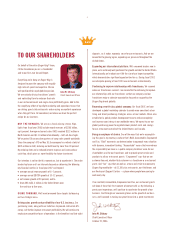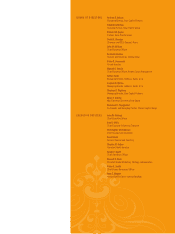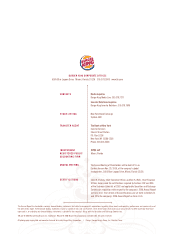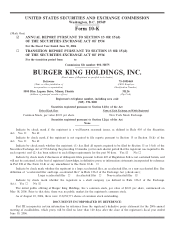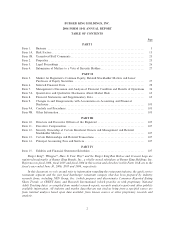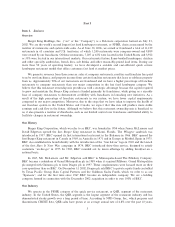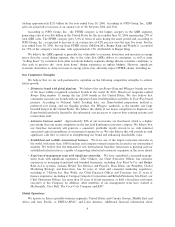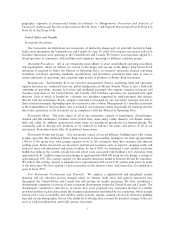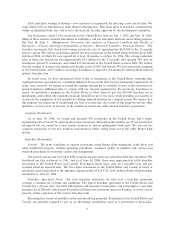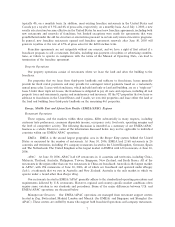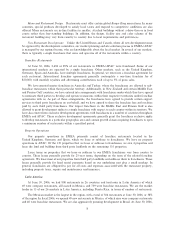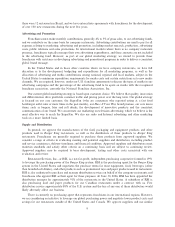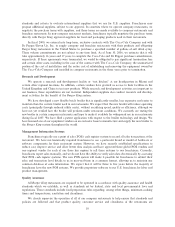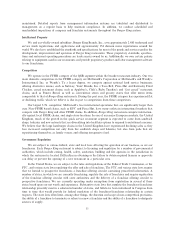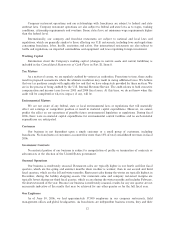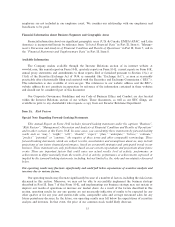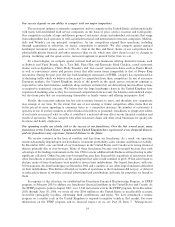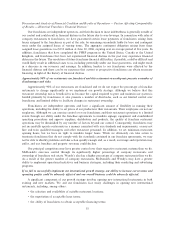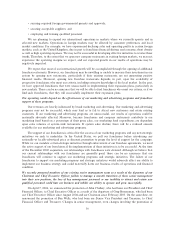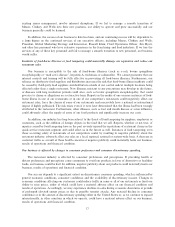Burger King 2006 Annual Report Download - page 19
Download and view the complete annual report
Please find page 19 of the 2006 Burger King annual report below. You can navigate through the pages in the report by either clicking on the pages listed below, or by using the keyword search tool below to find specific information within the annual report.typically 4%, on a monthly basis. In addition, most existing franchise restaurants in the United States and
Canada pay a royalty of 3.5% and 4% of gross sales, respectively, on a monthly basis. As of July 1, 2000, a new
royalty rate structure became effective in the United States for most new franchise agreements, including both
new restaurants and renewals of franchises, but limited exceptions were made for agreements that were
grandfathered under the old fee structure or entered into pursuant to certain early renewal incentive programs.
In general, new franchise restaurants opened and franchise agreement renewals after June 30, 2003 will
generate royalties at the rate of 4.5% of gross sales for the full franchise term.
Franchise agreements are not assignable without our consent, and we have a right of first refusal if a
franchisee proposes to sell a restaurant. Defaults, including non-payment of royalties or advertising contribu-
tions, or failure to operate in compliance with the terms of the Manual of Operating Data, can lead to
termination of the franchise agreement.
Property Operations
Our property operations consist of restaurants where we lease the land and often the building to the
franchisee.
For properties that we lease from third-party landlords and sublease to franchisees, leases generally
provide for fixed rental payments and may provide for contingent rental payments based on a restaurant's
annual gross sales. Leases with franchisees, which include land only or land and building, are on a ""triple net''
basis. Under these triple net leases, the franchisee is obligated to pay all costs and expenses, including all real
property taxes and assessments, repairs and maintenance and insurance. Of the 927 properties that we lease or
sublease to franchisees in the United States and Canada, we own 466 properties and lease either the land or
the land and building from third-party landlords on the remaining 461 properties.
Europe, Middle East and Africa/Asia Pacific (EMEA/APAC) Regions
Restaurant Operations
These regions, and the markets within these regions, differ substantially in many respects, including
customer taste preferences, consumer disposable income, occupancy costs, food costs, operating margins and
the level of competitive activity. The following discussion is intended as a summary of our EMEA/APAC
business as a whole. However, some of the information discussed below may not be applicable to individual
countries within our EMEA/APAC operations.
EMEA. EMEA is the second largest geographic area in the Burger King system behind the United
States as measured by the number of restaurants. At June 30, 2006, EMEA had 2,168 restaurants in 26
countries and territories, including 291 company restaurants located in the United Kingdom, Germany, Spain
and The Netherlands. The United Kingdom is the largest market in EMEA with 630 restaurants at June 30,
2006.
APAC. At June 30, 2006, APAC had 619 restaurants in 11 countries and territories, including China,
Malaysia, Thailand, Australia, Philippines, Taiwan, Singapore, New Zealand, and South Korea. All of the
restaurants in the region other than our two restaurants in China are franchised. Australia is the largest market
in APAC, with 294 restaurants at June 30, 2006, all of which are franchised and operated under Hungry
Jack's, a trademark that we own in Australia and New Zealand. Australia is the only market in which we
operate under a brand other than Burger King.
Our restaurants located in EMEA/APAC generally adhere to the standardized operating procedures and
requirements followed by U.S. restaurants. However, regional and country-specific market conditions often
require some variation in our standards and procedures. Some of the major differences between U.S. and
EMEA/APAC operations are discussed below.
Management Structure. Our EMEA/APAC operations are managed from restaurant support centers
located in Zug, Switzerland, Madrid, London and Munich (for EMEA) and Singapore and Shanghai (for
APAC). These centers are staffed by teams who support both franchised operations and company restaurants.
7



